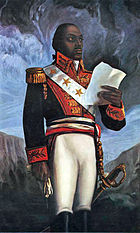San Miguel de Gualdape
| North American slave revolts |
|---|
 |
|
San Miguel de Guadalupe was the first European settlement in what would become the continental United States, founded in 1526 by Spanish explorer Lucas Vázquez de Ayllón. The settlers lasted only through three months of winter before abandoning the site in early 1527.
Records show that in 1521, de Ayllón, a wealthy sugar planter of Santo Domingo, had sent Francisco Gordillo northward to explore the continent. Upon reaching the Bahamas, he ran into his cousin, slave trader Pedro de Quexos (Pedro de Quejo), and the two set out together. They landed at the "River of St. John the Baptist", possibly the Pee Dee River, where they kidnapped 70 natives to sell in Hispaniola. One, whom they named Francisco de Chicora, provided some ethnological information about his province of Chicora, and the neighboring provinces. Chicora was evidently one of several Carolina Siouan-speaking territories subject to their king, Datha of Duahe (also recorded in Spanish as Duarhe). Spanish records described the Siouan captives as white, dressed in skins, and larger than the average Spaniard.
Ayllón obtained a patent from Charles V in 1523. In 1525 he sent Quexos to explore the coastline further. The trader killed the local natives and explored as far north as the Delaware Bay. He persuaded two natives from each district to return with him to learn Spanish, and thereafter act as interpreters for the colonists.
By mid-July 1526, Ayllón was ready to establish a colony with 600 settlers and 100 horses. He lost one of his three ships at a river he named the Jordan, probably the Santee. The remainder of the expedition landed in Winyah Bay, near present-day Georgetown, South Carolina, on September 29 (the Feast of Archangels). Francisco de Chicora left the group and escaped into the woods. Ayllón's party proceeded '40 or 45 leagues', partly overland and partly by boat, visiting the king of Duahe en route, as related by Peter Martyr. They reached another river, which they named the Guadalupe, where they built the mission San Miguel de Guadalupe on October 8.
...
Wikipedia
